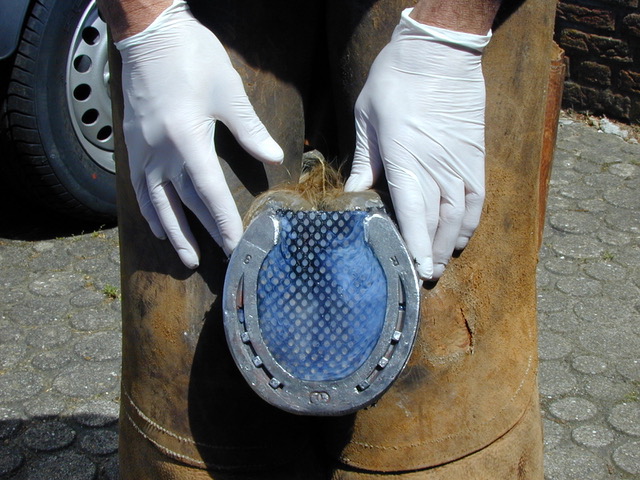Like a glove provides extra protection to human hands and fingers, pour-in pads serve as a safeguard for both shod and barefoot horses. Pour-in pads can provide solar support to both prevent and aid common hoof care issues.
Pour-in pads, made of urethane adhesives, bond to the sole of a hoof and produce a soft, resilient supportive pad material. Designed to increase the weight-bearing surface area, these materials alleviate pressure off the hoof wall and allow the sole to take on some of the horse’s weight.
Horse owners and farriers can utilize pour-in pads to create extra protection and provide support to prevent and manage hoof care issues.
Preventing Hoof Care Issues
The hooves support a horse’s whole body. It’s important for horse owners to take the necessary steps to prevent potential injury or infection. Pour-in pads can serve as a preventative tool for the following:
Bruising. Using a durable pour-in-pad material can help prevent sole bruising. As horse owners might not be able to see bruising until the healing process begins, it’s crucial for owners to be mindful of their horses’ environments and provide the proper support to avoid injuries or discomfort.
Moisture. To avoid infection or injury in changing climates, horse owners can use pour-in pad materials to help maintain optimal sole health. These pads bond to the bottom of a horse’s foot, sealing out moisture and preventing debris from being packed in the foot. Pour-in materials infused with copper sulfate also help to mitigate mild and moderate cases of thrush effectively.

A Treatment Tool
After suffering from injury or disease, pour-in pads help elevate pressure to make horses more comfortable throughout the healing process. Pour-in pads can serve as an effective component to a treatment plan for the following issues.
Abscess. An abscess, a collection of pus, develops within a horse hoof from trauma, excessive pressure or bruising. After the abscess opens, drains and heals, pour-in pads can be used around an abscessed area to support and protect the hoof as it heals. To apply pour-in pads, hoof care professionals should use Play-Doh or bread to cover the abscess while they pour the pad material to avoid any material covering the abscess. It’s critical that the abscess opening is not covered so it heals adequately.
Cracking. When horses distribute their weight unevenly, excessive force and stress on one area of the hoof wall can cause quarter cracks. Pour-in pads serve as a durable material to distribute a horse’s weight across the entire hoof-bottom to relieve pressure around a quarter crack. Additional cracking issues arise when moisture levels in horse hooves become inconsistent and result in superficial cracks in the hoof wall. If small superficial cracks open up to form larger cracks, pour-in pads keep pressure off the hoof wall and strengthen the hoof. Pads suspend movement and further distribute a horse’s weight evenly throughout the foot to avoid further cracks or lines for both superficial and severe cracking.
Frog atrophy. A contracted frog appears smaller in size and does not come in contact with the ground, indicating atrophy. Pour-in pad materials engage the frog and aid in opening the bulbs within the hoof over a period of time. Fast-setting, soft pad materials that bond directly to the sole and frog stimulate the frog to work and function normally. Pour-in pads help to widen the bulbs and distribute weight evenly throughout the foot during the healing process.
Laminitis. In the event of hoof trauma, blood flow reduction and inflammation can cause partial or total separation of the lamina, forcing the coffin bone to rotate downward. When a horse suffers from laminitis, pour-in pads can reduce the pull occurring on the lamina between the hoof wall and internal structures. Liquid pour-in pads are available with different firmness levels to minimize stress on a variety of hoof capsules. The pad material can be filled to ground level for maximum support and effectively absorb concussion for a faster recovery and a more comfortable horse. In acute cases, different pad applications, such as half pad, can provide tailored support.
Thin soles. If a horse has thin soles, pour-in pads can be a helpful way to regain and maintain sole thickness. After applying a pour-in pad to the sole, horses have a better chance of retaining thickness and re-growing. Pour-in pads can act as a “fake sole” for the horse, which prevents abrasive ground surfaces from wearing down a horse’s actual sole.
White line disease. When bacteria and fungus get trapped within the white line region that divides the outside of the hoof wall and the sole, the hoof wall begins to disappear as the anaerobic bacteria eats away the lining. After a hoof wall is resected, pour-in pads support the bottom of the foot to help maintain the plain of the coffin bone due to the loss of hoof wall.
For more information about pour-in pads for hoof care issues, visit Vettec.com/Equine.









Post a comment
Report Abusive Comment